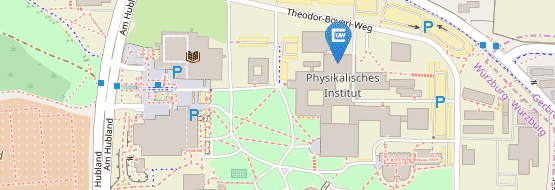TEP Seminar - Shlomi Bouscher
Superconductor-semiconductor hybrid devices and their applications
| Datum: | 02.12.2025, 11:00 Uhr |
| Ort: | A034 |
| Vortragende: | Shlomi Bouscher, Technion, Israel |
The combination of the well-established field of semiconductors together with the unique properties offered by the field of superconductors, has created a new research field that opens a path towards many unique applications such as novel sources, manipulators and detectors of quantum light and even new paradigms for quantum computing, that attempt to combine the best of both worlds of solid-state and photonics-based quantum computing.
One notable example is the superconducting light-emitting diode (SLED), which aims to use the spin-entangled nature of the superconducting electron (Cooper) pairs, to produce polarization-entangled photons [1,2,3]. This is done by coupling a superconductor to a semiconductor PN junction and applying forward bias voltage, causing Cooper-pair injection into the PN junction and their subsequent radiative recombination with hole pairs. The physical mechanism behind the SLEDs can, in principle, be used for a variety of applications. These include superconductor-coupled waveguides capable of two-photon gain [4] and Bell-state analyzers [5], but also applications in the field of quantum computing such as phase gates [6].
Another key application involves the use of a double superconducting contact, for both p and n-type contacts. This allows us to transfer the difference between two spatial phase profiles of the superconducting contacts, acting as a qubit, to the emitted photon pairs as well. Specifically, under the right conditions, it would be possible to transfer the superconducting phase difference onto photon pairs in orbital-angular-momentum (OAM) modes, which are of use in the field of quantum information.
[1] A. Hayat, H-Y. Kee, K. S. Burch, A. M. Steinberg, “Cooper-pair based photon entanglement without isolated emitters”, Phys. Rev. B, 89, 094508 (2014).
[2] D. Panna, S. Bouscher, K. Balasubramanian, V. Perepelook, S. Cohen, D. Ritter, and A. Hayat, “Andreev reflection in a superconducting light-emitting diode”, Nano Letters 18, 6764 (2018).
[3] Shlomi Bouscher, Dmitry Panna, Ronen Jacovi, Fauzia Jabeen, Christian Schneider, Sven Höfling and Alex Hayat, “Two-photon emission from a superlattice-based superconducting light-emitting structure”, Light Sci. Appl. 13, 135 (2024).
[4] R. Marjieh, E. Sabag and A. Hayat, “Light amplification in semiconductor-superconductor structures”, New J. Phys. 18, 023019 (2016).
[5] E. Sabag, S. Bouscher, R. Marjieh, and A. Hayat, “Photonic Bell-state analysis based on semiconductor-superconductor structures”, Phys. Rev. B 95, 094503 (2017).
[6] Shlomi Bouscher and Alex Hayat, “Universal photonic quantum gate by Cooper-pair-based optical nonlinearity”, Phys. Rev. B 107, 144516 (2023).


